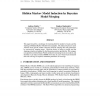Free Online Productivity Tools
i2Speak
i2Symbol
i2OCR
iTex2Img
iWeb2Print
iWeb2Shot
i2Type
iPdf2Split
iPdf2Merge
i2Bopomofo
i2Arabic
i2Style
i2Image
i2PDF
iLatex2Rtf
Sci2ools
NIPS
1992
1992
Hidden Markov Model} Induction by Bayesian Model Merging
This paper describes a technique for learning both the number of states and the topologyof Hidden Markov Models from examples. The inductionprocess starts with the most specific model consistent with the training data and generalizes by successively merging states. Both the choice of states to merge and the stopping criterion are guided by the Bayesian posterior probability. We compare our algorithm with the Baum-Welch method of estimating fixed-size models, and find that it can induce minimal HMMs from data in cases where fixed estimation does not converge or requires redundant parameters to converge.
| Added | 07 Nov 2010 |
| Updated | 07 Nov 2010 |
| Type | Conference |
| Year | 1992 |
| Where | NIPS |
| Authors | Andreas Stolcke, Stephen M. Omohundro |
Comments (0)

